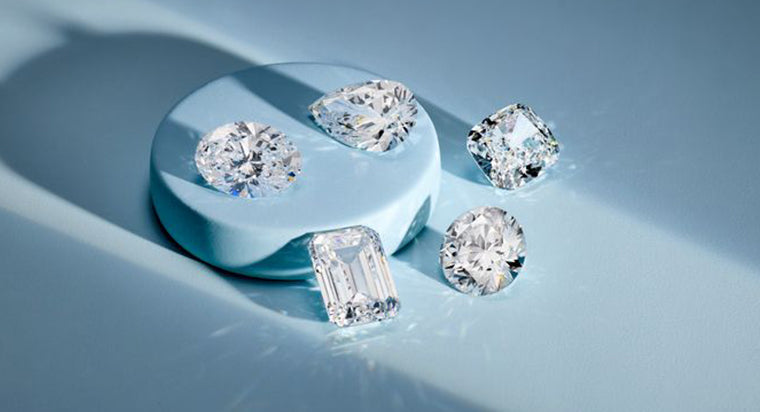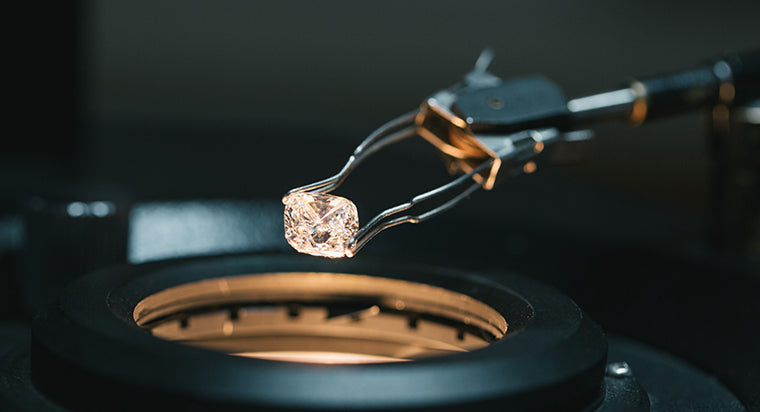Moissanite vs. Diamond vs. Cubic Zirconium: What to Know
TABLE OF CONTENTS
Choosing an Engagement Ring Stone
When you're shopping for an engagement ring, cost is usually one of the biggest factors in picking a style, metal and gemstone. Should you go with traditional diamonds, or a manmade stone such as moissanite or cubic zirconium? First, it's important to understand the characteristics of each.
Many may believe the difference between moissanite, cubic zirconium and diamonds is minimal, but in actuality, each stone provides a completely different effect.
What is Moissanite?
Unlike most other stones, moissanite is out of this world — literally. It was discovered in 1893 by Henri Moissan, who found microscopic particles of what is now known as moissanite in a crater left by a meteorite strike in Arizona. At first glance, Moissan believed he found diamonds, but upon further examination, he discovered that the particles were made up of silicon carbide instead of carbon.
Moissanite is rarely found in nature, and therefore most moissanite gems are now made in labs. Although moissanite is created to mimic a diamond, there are a few distinct differences.
Moissanite vs Diamond Side by Side
Compared to diamonds, moissanite is rated lower on the Mohs Scale of Hardness. Although it comes in at 9.25 (making it a very durable stone), the diamond receives a perfect 10. The .75 difference is not enough to discount the high durability of the moissanite. Both stones are suitable for everyday wear as an engagement ring. But in terms of hardness, a diamond is still the pinnacle.
As far as brilliance goes, moissanite has a distinctly different effect than a diamond. Moissanite has a different faceted pattern which creates a rainbow-like effect. While some buyers adore this splash of color, others say the stone resembles a disco ball more than a diamond. This effect is only heightened when the size of the stone increases. Diamonds, in comparison, simply display their famous sparkle.
Although colorless diamonds project a white appearance, the so-called “colorless” moissanites may still appear yellowish or grayish. What moissanite lacks in hardness, brilliance, and color, it makes up for in price. Moissanite engagement rings are significantly cheaper than their diamond counterparts. Although they're still more expensive than moissanite, lab-made diamonds are cheaper than naturally found diamonds.

Cubic Zirconium Origins
Cubic zirconium engagement rings are also common alternatives to diamonds. This stone is completely manufactured in a lab, but is designed to match the sparkle of a natural diamond. It gets its name from its cubic crystal symmetry and chemical composition of zirconium oxide.
Cubic zirconia is treasured because it is easy to care for but still reminds the buyer of a diamond. Unlike moissanite, cubic zirconia can be made completely colorless, making this stone on par with a diamond in terms of color.
German mineralogists discovered naturally occurring cubic zirconia, but the actual manufacturing of single-crystal cubic zirconia began in France in the 1960s, and the Soviets eventually perfected its manufacture. Although lab-made diamonds and cubic zirconia are both manufactured artificially, there is a distinct difference. Lab-made diamonds are composed of carbon atoms (like mined/natural diamonds), while cubic zirconia are simply manufactured to only look like diamonds.
Diamonds vs Cubic Zirconium
Compared to diamonds, cubic zirconia is significantly cheaper. Therefore, for any buyer wanting a particular setting, style, or ring, cubic zirconia might be an inexpensive choice. Additionally, the wait times are typically much shorter when ordering cubic zirconia instead of diamonds.
Although cubic zirconia is still durable, it does not compare to the hardness of a diamond; its rating on the Mohs Scale of Hardness is 8.5. However, because it's artificially created in a lab, cubic zirconia is inherently flawless. Diamonds, on the other hand, are very rarely (almost never) flawless.
If you want a stone that shines, a diamond is the best bet. Cubic zirconia has a much lower refractive index than a diamond, so it captures light differently and shines less.
Every stone has pros and cons, but a diamond is almost always the preferred gem for an engagement ring. Rated a perfect 10 on the Mohs Scale of Hardness, a (mined or lab) diamond is incredibly durable and suitable for everyday wear. Additionally, the color is pure and without tints of yellow or gray. In terms of sparkle and shine, no other diamond substitute compares.
Price, of course, is always higher for a diamond, but so is the value. The wearer will receive a much more durable and brilliant stone, making a diamond engagement ring a treat to show off to family and friends.
Identifying Natural and Simulated Diamonds
Diamond identification is critical. Simulated diamonds tend to have "tells” that may help you notice whether they are real or not.
- First, natural diamonds tend to have a brighter color. The reflection of sparkle is higher for natural diamonds, versus a stone like cubic zirconia. Since, cubic zirconia has a lower refractive index so it captures light differently. A spectrometer is a tool that can help in this endeavor. This instrument can help determine the structural and growth patterns in the carbon substance.
- Another interesting test is thermal conductivity. Diamonds conduct and react to heat. Most simulants do not. Additionally, a gemstone like moissanite (a diamond simulant) will even conduct electricity.
- Simulants tend to have lower hardness on the Mohs scale than diamonds, making them more likely prone to chipping or breakage. Their artificial creation can mean few or no clarity inclusions. Additionally, they are often made very colorless so they look extremely white.
- Finally, price is a tell all. If they are priced too well (fraction of the price of a natural diamond), then you'll have a signal that the diamond may not be natural.
FAQs
Which is the best stone for an engagement ring?
Is moissanite the same as a diamond?
Is cubic zirconia the same as a diamond?
How do you identify a natural diamond?
How can you tell a diamond from glass?









